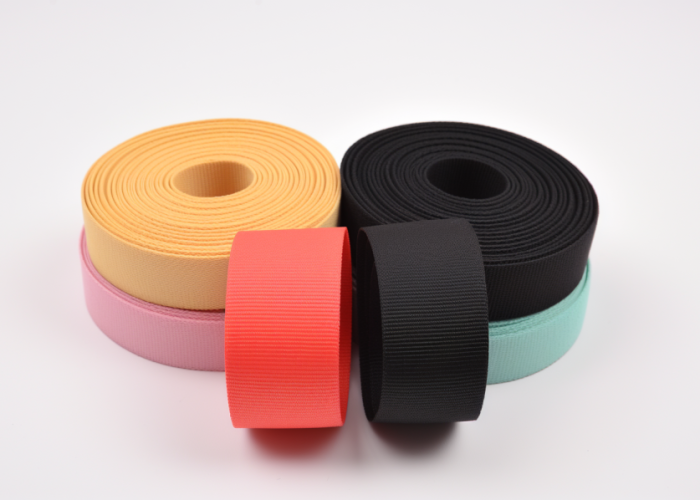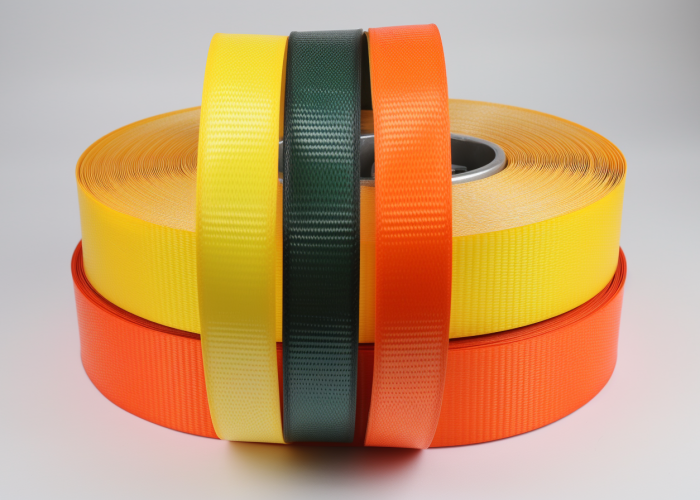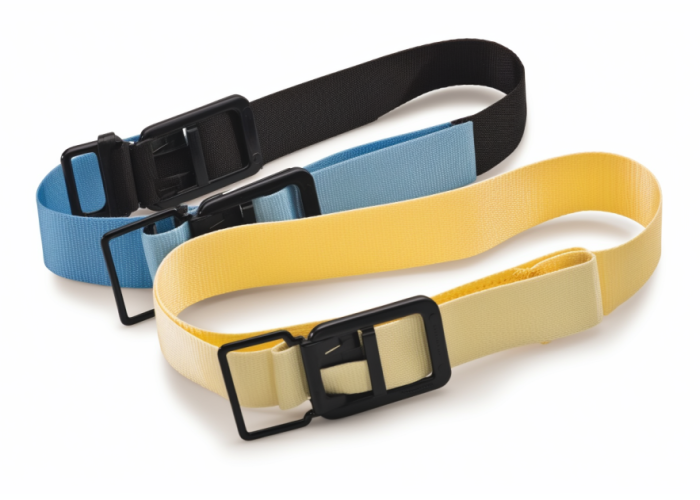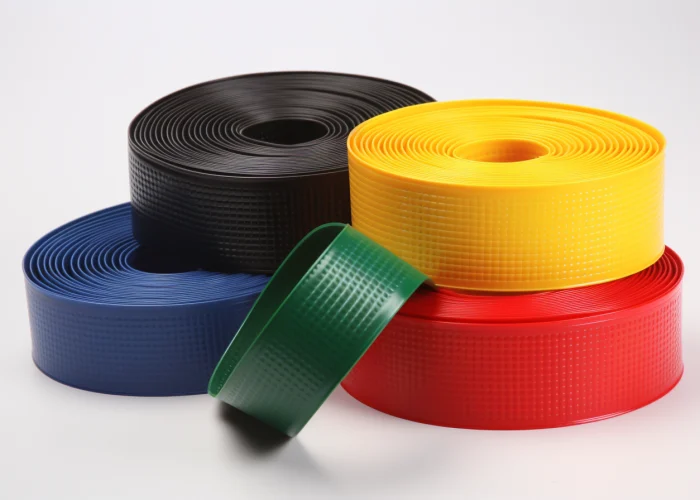Selecting the optimal webbing material for medical applications requires engineering expertise in both material science and manufacturing processes. As webbing manufacturers specializing in medical-grade solutions, our technical team helps device developers navigate the complex balance of chemical resistance, biocompatibility, sterilization compatibility, and performance requirements that impact your product’s success.
High-tenacity polyester, polypropylene, and TPU-coated webbing are three most preferred materials for medical-grade webbing , each offering distinct performance characteristics for specific medical applications. High-tenacity polyester provides superior tensile strength (6,000-8,000 psi) for critical load-bearing applications, polypropylene offers exceptional chemical resistance for disposable components, and TPU-coated webbing delivers antimicrobial properties with waterproof protection that meets ISO 10993 biocompatibility standards.
Compare material properties and chemical resistance to find the right medical webbing. Get expert tips for performance, durability, and compliance.


Webbing manufacturing expert with 15+ years of experience helping product developers build high-performance straps for industrial, medical, and outdoor use.
High-tenacity polyester webbing typically delivers 6,000-8,000 lbs breaking strength for 2-inch width even after repeated sterilization, making it ideal for critical medical applications requiring durability and chemical resistance. This polyethylene terephthalate (PET) construction provides exceptional durability while resisting oils, acids, solvents, and bodily fluids, making it the preferred choice for critical load-bearing applications in healthcare environments.
Key benefits at a glance:
High-tenacity polyester’s specialized molecular structure yields 15-25% greater strength than standard polyester, maintaining dimensional stability through repeated sterilization cycles at temperatures up to 134°C. Material testing provides comprehensive documentation for regulatory submissions, including reports suitable for FDA 510(k) and MDR compliance.
ASTM D543 testing confirms exceptional chemical resistance, with 95.7% strength retention after 100 cleaning cycles with hydrogen peroxide, 96.2% with quaternary ammonium compounds, and 97.3% with isopropyl alcohol. Sample quantities are available for prototyping and validation testing prior to full production.
The material excels in diverse medical applications due to its specific performance characteristics. Surgical restraints benefit from minimal elasticity (<3% elongation), maintaining precise positioning. Patient transfer systems leverage its load-bearing capacity (5:1 safety factor) and optimal grip (0.42-0.47 coefficient of friction). Equipment straps utilize its dimensional stability (±0.5% change after sterilization) for securing sensitive instruments.
The process includes material selection based on your application, prototyping with tested samples, and in-line quality control to ensure consistent performance across all production batches.
Polypropylene webbing excels in disposable medical applications due to its exceptional chemical resistance to disinfectants, lightweight construction (30-40% lighter than polyester), and cost-effectiveness for single-use scenarios. This versatile material withstands exposure to acids, alkalis, solvents, and bodily fluids while maintaining structural integrity, making it the preferred choice for non-load-bearing disposable components in healthcare settings.
Key benefits at a glance:
Polypropylene’s semi-crystalline molecular structure with minimal polar groups limits chemical bonding sites, providing exceptional resistance to hydrogen peroxide, quaternary ammonium compounds, and alcohol-based sanitizers. This resistance maintains material integrity even after multiple disinfection cycles during limited-use applications.
The material’s limited moisture absorption (less than 0.01% by weight) reduces concerns about bacterial growth in humid environments, while its natural hydrophobicity helps prevent fluid penetration and cross-contamination during procedures. Regulatory documentation supporting biocompatibility claims is available for validation in specific applications.
Polypropylene demonstrates versatility across numerous disposable medical applications. Collection bags benefit from its chemical resistance and leak-resistant heat-sealing properties. Lightweight filter media applications leverage its high surface area-to-weight ratio and chemical stability. Procedure kits utilize its cost-effective properties for single-use components.

TPU-coated webbing combines a durable webbing substrate with thermoplastic polyurethane coating that creates waterproof, antimicrobial, and easy-to-clean surfaces ideal for medical devices requiring frequent disinfection and patient contact. This specialized construction meets ISO 10993 biocompatibility standards for skin contact while providing enhanced protection against fluid penetration and microbial contamination.
Key benefits at a glance:
The thermoplastic polyurethane forms a continuous film with excellent elasticity (300-500% elongation before break) while maintaining strong adhesion to the underlying webbing substrate. This construction provides waterproof protection without compromising flexibility, allowing for comfortable patient contact while preventing fluid penetration.
The material withstands repeated exposure to hospital-grade disinfectants while maintaining surface integrity and coating adhesion. Its smooth surface minimizes crevices where bacteria could accumulate, while some formulations incorporate antimicrobial additives that actively inhibit microbial growth on the material surface.
The material excels in applications requiring enhanced infection control. MRI and CT scan straps benefit from easy cleaning between patients while providing secure positioning. Orthopedic bracing applications utilize the material’s combination of support and cleanability. Patient transfer devices leverage its waterproof properties and skin-friendly surface texture.
Polypropylene offers the strongest resistance to acids and alkalis, high-tenacity polyester provides excellent stability with disinfectants and solvents, while TPU-coated webbing excels against alcohols and quaternary ammonium compounds used in healthcare settings. Each material demonstrates specific performance advantages against the chemical challenges commonly encountered in medical applications.
Key comparison factors at a glance:
Chemical resistance testing according to ASTM D543 standards provides quantitative comparison data across materials. Polypropylene demonstrates exceptional resistance to acids and bases, with less than 1% weight change after 7-day immersion in 10% sulfuric acid. High-tenacity polyester shows superior dimensional stability with less than 0.5% dimensional change after repeated exposure to disinfectants.
For repeated exposure to strong disinfectants in reusable applications, high-tenacity polyester typically offers the best combination of chemical resistance and durability. For disposable items exposed to acids or aggressive chemicals, polypropylene provides cost-effective resistance. For applications requiring frequent cleaning with hospital disinfectants, TPU-coated webbing offers superior cleanability with minimal degradation.

High-tenacity polyester tolerates all major sterilization methods including autoclave (134°C), ETO, and gamma radiation, while polypropylene works with ETO and gamma but not steam, and TPU-coated webbing compatibility depends on the substrate material and coating formulation. Understanding these compatibility differences is crucial for medical device design and reprocessing protocol development.
Key sterilization compatibility factors:
High-tenacity polyester demonstrates exceptional tolerance to autoclave conditions, maintaining dimensional stability and tensile strength even after repeated cycles at 134°C. Polypropylene’s lower melting point (approximately 140°C) makes it unsuitable for steam sterilization, as it may deform or weaken. TPU-coated webbing on a polyester substrate typically withstands autoclave conditions, though some coating formulations may require lower temperature cycles (121°C).
Ethylene oxide (ETO) sterilization provides a low-temperature alternative compatible with all three material types. Gamma radiation sterilization compatibility varies by material and dose requirements, with high-tenacity polyester showing minimal effect on tensile properties while polypropylene may experience some oxidative degradation at higher dose levels.
Material selection should consider both initial sterilization method and potential reprocessing requirements throughout the device lifecycle. Testing with the specific sterilization parameters planned for the finished device is recommended to validate material performance.
Medical webbing material selection should prioritize five critical factors: chemical resistance profile, sterilization compatibility, mechanical performance requirements, biocompatibility needs, and lifecycle considerations including single-use versus reusable applications. Balancing these factors ensures optimal material selection that meets both technical requirements and patient safety standards.
Key selection considerations at a glance:
For TPU-coated webbing, coating substance performance represents a critical consideration. The coating creates a barrier that enhances chemical resistance while improving cleanability, but coating integrity must be maintained throughout the product lifecycle. Factors affecting coating performance include thickness uniformity, adhesion to the substrate, and resistance to cracking or delamination during use.
Sterilization limits vary significantly between materials and directly impact application suitability. High-tenacity polyester offers the broadest sterilization compatibility but at a higher cost than alternatives. Polypropylene provides excellent chemical resistance with ETO and gamma compatibility at lower cost, making it ideal for limited-use applications.
Long-term material performance factors include resistance to repeated cleaning, maintenance of mechanical properties after multiple sterilization cycles, and stability of appearance characteristics. Material selection should begin with clearly defining performance requirements, followed by systematic evaluation of candidate materials against these criteria.

Different medical applications require specific material properties: patient positioning devices demand high-strength polyester for load-bearing capability, disposable items benefit from lightweight polypropylene for cost-effectiveness, and infection-control critical applications need TPU-coated webbing for cleanability and waterproof protection. Understanding application-specific requirements ensures optimal material selection for medical device design.
Key application-specific considerations:
High-tenacity polyester provides optimal performance for patient transfer systems with breaking strengths of 6,000-8,000 lbs for 2-inch webbing and minimal creep under sustained loading. Critical safety factors must be incorporated into design calculations for load-bearing applications, typically 5:1 for medical devices involving patient support.
Disposable applications benefit from polypropylene’s lightweight construction (30-40% lighter than polyester) which reduces material consumption while its chemical resistance ensures performance integrity during limited use. The material’s lower cost structure makes it economically viable for single-use items.
Infection control applications often require TPU-coated webbing’s enhanced cleanability. The smooth, sealed surface eliminates crevices where bacteria could accumulate and provides a waterproof barrier against fluid penetration, making it ideal for applications requiring frequent disinfection between patients.
Long-term performance varies significantly: high-tenacity polyester maintains 95%+ strength after 100 sterilization cycles making it ideal for durable medical equipment, polypropylene offers excellent initial performance but limited reprocessing capability suited for disposables, and TPU-coated webbing provides intermediate durability with superior infection control properties. Understanding these differences enables appropriate material selection based on expected service life.
Key long-term performance factors:
High-tenacity polyester demonstrates minimal degradation under accelerated aging conditions (ASTM F1980), with retention of 90%+ tensile properties after simulated aging equivalent to 5+ years of use. Polypropylene shows good initial stability but may exhibit property changes under extended aging conditions, supporting its use in limited-life applications.
Environmental factors significantly impact long-term performance. Exposure to UV light can degrade polypropylene through oxidative mechanisms, while high humidity environments may affect coating adhesion in some TPU-coated materials. High-tenacity polyester demonstrates exceptional environmental stability across diverse conditions.
For equipment expected to remain in service for 5+ years with frequent reprocessing, high-tenacity polyester typically represents the optimal choice despite higher initial cost. For limited-use applications, polypropylene offers an excellent combination of performance and economy. For intermediate applications requiring enhanced infection control, TPU-coated webbing provides an effective solution.
Selecting the right medical webbing material requires balancing chemical resistance, sterilization compatibility, mechanical properties, and lifecycle considerations. High-tenacity polyester excels in durability, polypropylene offers cost-effective disposable solutions, and TPU-coated webbing provides superior infection control. Contact us to explore manufacturing solutions tailored to your medical device webbing requirements, including custom material development, engineering consultation, and regulatory documentation support.
Yes, medical-grade webbing can be biocompatible with skin contact when properly selected and tested. High-tenacity polyester and TPU-coated webbing typically meet ISO 10993-5 cytotoxicity and ISO 10993-10 skin irritation standards. TPU-coated options offer the best skin-friendly surface properties, while untreated polypropylene requires additional testing for prolonged skin contact applications.
Medical webbing must comply with ISO 10993 biocompatibility standards, device-specific requirements from ISO 13485, and load-bearing applications require adherence to safety factor guidelines (typically 5:1). Additional standards may include flammability testing (16 CFR 1610), cytotoxicity evaluation (ISO 10993-5), and application-specific requirements for implantable or critical-use devices.
Sample quantities (10-25 yards) are typically available with 1-2 week lead times, while production orders (500+ yards) generally require 3-4 weeks. MOQs vary by material: 500 yards for standard high-tenacity polyester, 1,000 yards for specialized polypropylene constructions, and 300 yards for TPU-coated options. Rush production capabilities are available for time-sensitive medical projects.
Environmental factors significantly impact durability, with UV exposure degrading polypropylene, high humidity potentially affecting TPU coating adhesion, and chemical disinfectants gradually reducing material performance. High-tenacity polyester offers the best environmental stability, while application-specific testing is recommended to validate performance under your specific environmental conditions, especially for outdoor medical equipment.
Repeated sterilization affects each material differently, with high-tenacity polyester maintaining 95%+ strength after 100 autoclave cycles, while polypropylene is limited to ETO and gamma methods only. TPU-coated webbing’s performance depends on coating quality, with premium formulations withstanding 20-30 cycles before showing degradation. Always verify specific material performance through testing in your sterilization environment.
Customization options include specialized weave patterns, width variations (0.5″-4″), edge treatments, printed measurement indicators, antimicrobial additives, and specialized coatings. Technical capabilities extend to custom dyeing for color-coding, specialized stiffness control through heat-setting, and hybrid constructions combining multiple materials for optimized performance in specific medical applications.